Previous Chapter « Table of Contents » Next Chapter
The case studies in the following pages show projects in the United States that demonstrate how sustainability is integrated through planning, design, construction, maintenance, and operations.
These case studies were selected because they were either under construction or recently constructed and due to their successful integration of sustainability practices. Site visits to projects that were under construction provided the opportunity to speak directly to FHWA staff, NPS staff, and project contractor(s). These conversations provided valuable insight into the communications between agencies in the field and the on-the-ground implementation of sustainability practices. Additional site visits are planned in the future, and this report will be updated with insights from those projects.
The case studies in this section show how sustainability was integrated into the design and construction process. As described in the Introduction to this guidebook, sustainable solutions should be incorporated early in the planning and design process and then revisited through construction and maintenance to maximize their success over the life of a project.
The concepts described in this guidebook were also observed in the field. A sampling of sustainability concepts within the case studies include:
The variety of sustainability concepts reflected in these case studies shows that this is not a one-size-fits- all approach. Solutions need to be tailored to the unique project context and conditions.
Case Study
TOWER FALLS TO TOWER CANYON
YELLOWSTONE NATIONAL PARK
The Federal Lands Highway (FLH), in partnership with the National Park Service, initiated reconstruction of a 2.5-mile stretch of road between Tower Junction and Tower Falls in the northeast section of Yellowstone National Park. The project also included reconstruction of the Canyon Village parking lot and replacement of the Obsidian Creek Bridge at the Indian Creek Campground. The road has tight curves, steep hillsides, and natural walls that make construction challenging. The project exhibited sustainable construction practices, including the following:
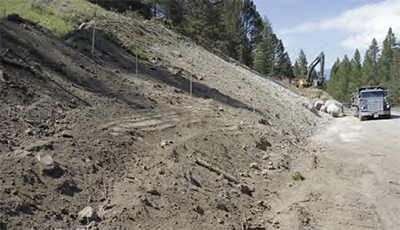
Topsoil is pushed to the top of slope for placement following construction.
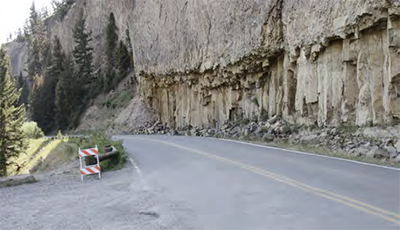
Vertical walls make construction challenging through this area.
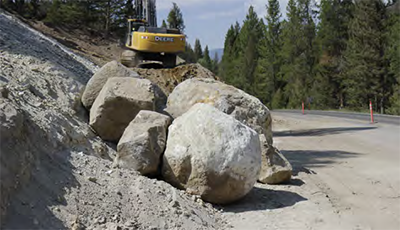
Large boulders are excavated and placed elsewhere in the project area.
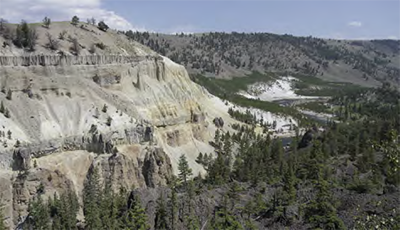
View from the corridor to the valley below
Case Study
MADISON TO NORRIS
YELLOWSTONE NATIONAL PARK
The Madison to Norris project is located on the western section of the Grand Loop in Yellowstone National Park. This 10-mile project addressed multiple deficiencies in pavement, drainage, alignment, and safety using sustainable construction methods and new features that enhanced the visitor experience. The road was widened to 30 feet. Two miles of new alignment were created upstream of Gibbon Falls, mitigating an impacted area and restoring it to natural conditions - prime riparian habitat. Specific sustainable features included:
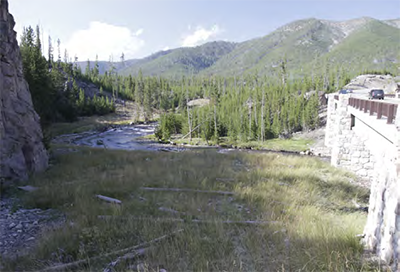
Little evidence exists of the former roadway alignment along the Gibbon River.
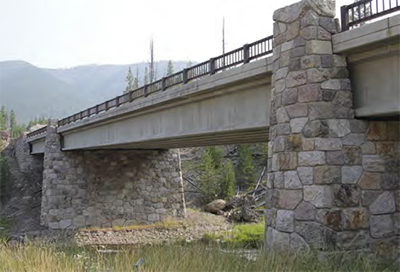
New alignment with retaining walls of native stone and bridge over the Gibbon River.
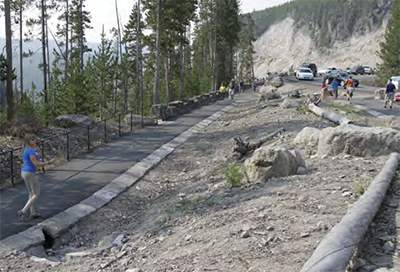
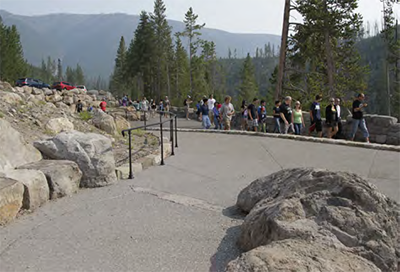
An expanded parking area and pedestrian pathways provide access to the falls viewing area.
Case Study
TETON PATHWAYS
GRAND TETON NATIONAL PARK
The FLH partnered with Grand Teton National Park to plan and construct a 10-foot wide multi-use pathway for cyclists and pedestrians, connecting Jackson Hole, Wyoming, to Grand Teton National Park. The pathway becomes a visitor experience of its own while augmenting the opportunities and modes that visitors use to experience the park. Elements of sustainability are woven into the construction, the visitor experience, and the maintenance of the pathways.
The route connects the County pathway from Jackson Hole to Moose Junction along approximately 8 miles of a separated pathway through the sagebrush flats east of the Teton Range. Path users can view grazing bison
and elk. Interpretive signage helps orient and educate path users who will be traveling at a pace ideal for continual interaction with the landscape. The pathways feed into the visitor circulation systems within the busiest part of the park while signals, signage, and integrated pathway design emphasizes safety for vehicle and non-vehicle users.
Sustainability is integrated into the experience. Instead of visiting the park via automobile, the pathway encourages visitors to experience the park by other modes, lessening the environmental impact caused by vehicles and expanding recreational opportunities.
Experiencing the park at a slower pace allows visitors to see more of the environment without potentially harming wildlife. Highlighting wildlife crossings, natural, and historic locations with signage educates visitors - an important step toward cultivating a sense of environmental ethic and responsibility.
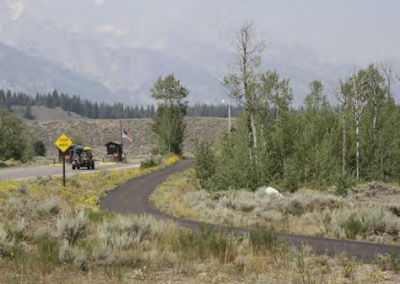
bicycle racks
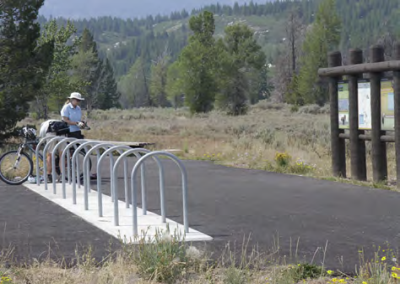
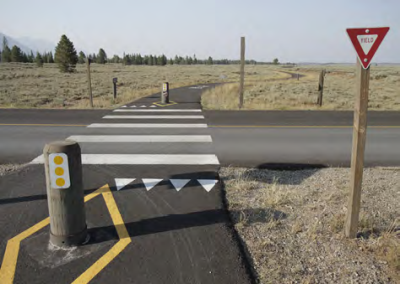
Trail crossing
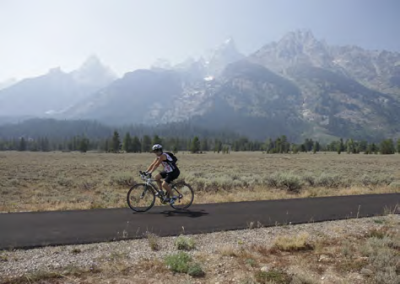
Pathway
Case Study
GOING-TO-THE-SUN ROAD
GLACIER NATIONAL PARK
The "Sun Road" is a 50-mile two-lane highway that winds through Glacier National Park, up the slopes of the Continental Divide, and over Logan Pass. Mostly built between 1921 and 1937, the road is considered an engineering feat and National Historic Landmark. The roadway and roadside embody sustainable design practices from a number of perspectives:
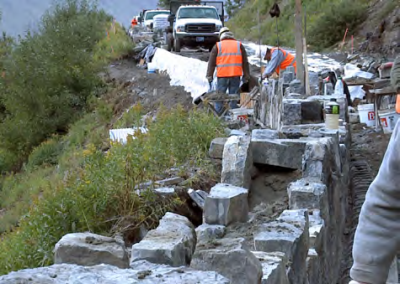
Installation of guard walls with reinforced concrete;
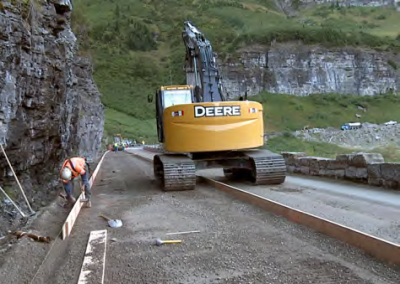
Roadway construction;
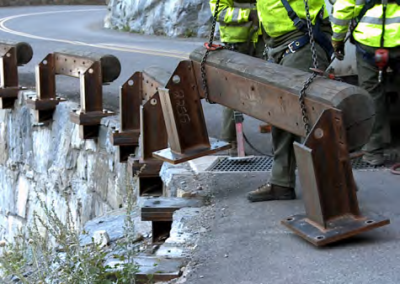
Removable guardrail installation
Source: "Preserving a Landmark in the Sky: Rehabilitation of the Going-to-the-Sun Road" (2008).
Case Study
KATHERINE ACCESS ROAD
LAKE MEAD NATIONAL RECREATION AREA, ARIZONA
This project involved a combination of widening and overlaying the existing road bed to alleviate unsafe and inadequate lane widths along a 3.8-mile stretch of Katherine Access Road. Safety enhancements included asphalt curbing and guardrail replacements, updating existing culverts, and evaluating and improving the design of the boat launch and parking area to alleviate drainage problems and facilitate safer traffic movements. Initial safety issues documented along the roadway included:
To mitigate these roadside safety concerns, the project team instituted sustainable practices:
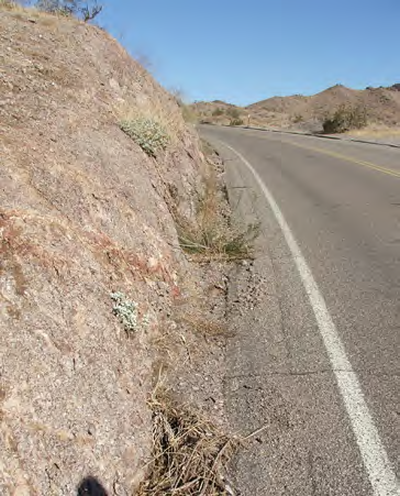
Steep roadside embankments without shoulder
The images show the pre-existing condition as project construction has not yet begun.
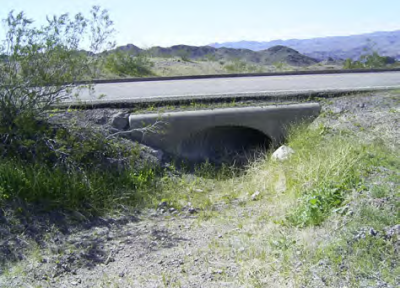
Culvert entrances located within clear zone, creating a hazard for motorists.
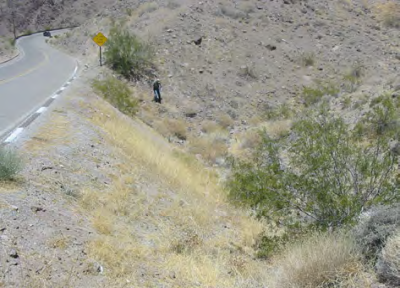
Steep side slopes without guardrails.